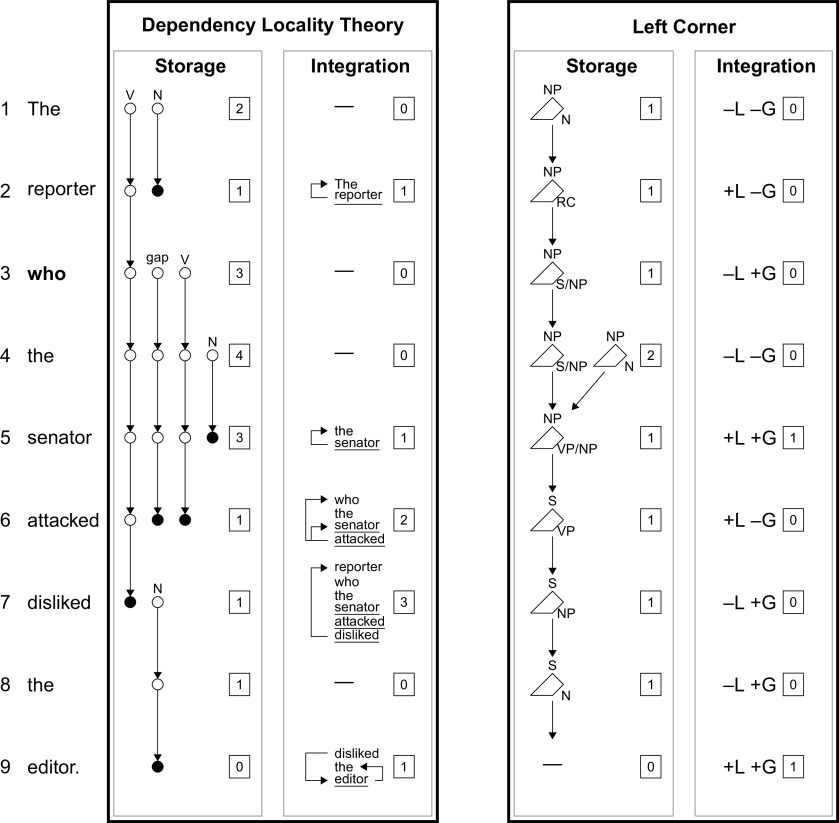Figure 2.
Visualization of storage and integration and their associated costs in two of the three frameworks investigated here: the DLT (Gibson, 2000) versus left corner parsing theory (e.g., Rasmussen and Schuler, 2018). [The third framework—ACT-R (Lewis and Vasishth, 2005)—assumes a left corner parsing algorithm as in the figure above but differs in predicted processing costs, positing (1) no storage costs and (2) integration costs continuously weighted both by the recency of activation for the retrieval target and the degree of retrieval interference.] Costs are shown in boxes at each step. DLT walk-through: in the DLT, expected incomplete dependencies (open circles) are kept in WM and incur storage costs (SCs), whereas dependency construction (closed circles) requires retrieval from WM of the previously encountered item and incurs integration costs (ICs). DRs (effectively, nouns and verbs) that contribute to integration costs are underlined in the figure. At “The,” the processor hypothesizes and stores both an upcoming main verb for the sentence (V) and an upcoming noun complement (N). At “reporter,” the expected noun is encountered, contributing 1 DR and a dependency from “reporter” to “the,” which frees up memory. At “who,” the processor posits both a relative clause verb and a gap site, which is coreferent with “who,” and an additional noun complement is posited at “the.” The expected noun is observed at “senator,” contributing 1 DR and a dependency from “senator” to “the.” The awaited verb is observed at “attacked,” contributing 1 DR and two dependencies, one from “attacked” to “senator” and one from the implicit object gap to “who.” The latter spans 1 DR, increasing IC by 1. When “disliked” is encountered, an expected direct object is added to storage, and a subject dependency to “reporter” is constructed with an IC of 3 (the DR “disliked,” plus 2 intervening DRs). At the awaited object “editor,” the store is cleared and two dependencies are constructed (to “the” and “disliked”). Left corner walk-through: the memory store contains one or more incomplete derivation fragments (shown as polygons), each with an active sign (top) and an awaited sign (right) needed to complete the derivation. Storage cost is the number of derivation fragments currently in memory. Integration costs derive from binary lexical match (L) and grammatical match (G) decisions. Costs shown here index ends of multiword center embeddings (+L +G), where disjoint fragments are unified (though other cost definitions are possible, see below). At “the,” the processor posits a noun phrase (NP) awaiting a noun. There is nothing on the store, so both match decisions are negative. At “reporter,” the noun is encountered (+L) but the sentence is not complete (–G), and the active and awaited signs are updated to NP and relative clause (RC), respectively. At “who,” the processor updates its awaited category to S/NP [sentence (S) with gapped/relativized NP]. When “the” is encountered, it is analyzed neither as S/NP nor as a left child of an S/NP; thus, both match decisions are negative and a new derivation fragment is created in memory with active sign NP and awaited sign N. Lexical and grammatical matches occur at “senator,” unifying the two fragments in memory, and the awaited sign is updated to VP/NP [verb phrase (VP) with gapped NP, the missing unit of the RC]. The awaited VP (with gapped NP) is found at “attacked,” leading to a lexical match, and the awaited sign is updated to the missing VP of the main clause. The next two words (“disliked” and “the”) can be incorporated into the existing fragment, updating the awaited sign each time, and “editor” satisfies the awaited N, terminating the parse. Comparison: both approaches posit storage and integration (retrieval) mechanisms, but they differ in the details. For example, the DLT (but not left corner theory) posits a spike in integration cost at “attacked.” Differences in predictions between the two frameworks fall out from different claims about the role of WM in parsing.

